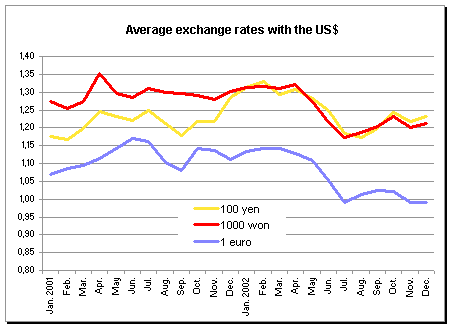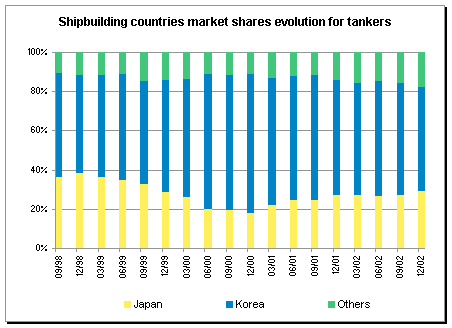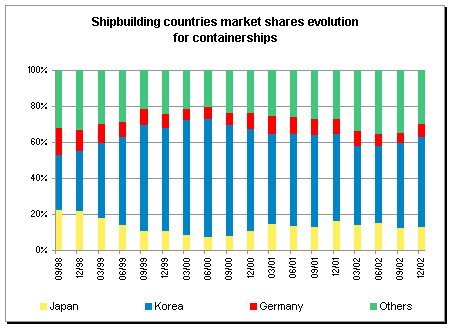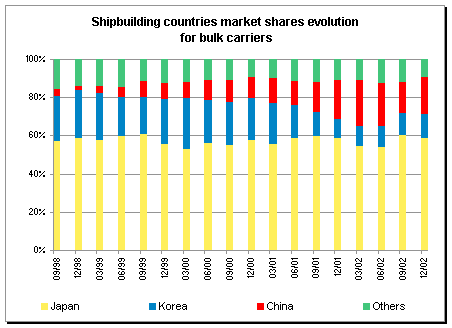
| The Shipbuilding market in 2002 (2) |
|
| Analysis by country |
| Asia |
|
|
|
At the end of the year Japan boasts an orderbook of 25 million gt, its
best performance since the oil shock of 1973. It may be recalled that in 1973 Japan
recorded 33 million gt of new orders and that in 1974 the Japanese orderbook stood at 50
million gt, out of a world total of 120 million gt.
The level of orders contracted in 2002 surpasses 12 million gt according to the statistics
of the Japanese Shipbuilders Exporters Association (JSEA). Japanese shipyards sign
contracts for 201 bulk carriers, more than double last year's figure. Japan also manage
to secure 9 out of the 16 orders for LNG carriers in 2002 whilst Korea succeeded in
securing 20 out of 27 last year.
Its market share increases, going from 25 % to nearly 32 % of the world orderbook.
Once again, Japanese builders are able to take advantage of the weakness of the yen
compared to the dollar. The Japanese currency goes over 135 yen/$ in January before
appreciating to 115 yen/$ in July.

On October 1st 2002, NKK and Hitachi merge their shipbuilding
activities by creating Universal Shipbuilding Corporation (USC) and initiate the way to
the first major restructuring of shipbuilding in Japan. At a time when it is important to
be large enough to benefit from economies of scale, USC becomes the second largest
shipbuilder in Japan with Imabari, behind Mitsubishi Heavy Industries.
IHI and Sumitomo Heavy Industries formed IHI Marine United in October 2002.
Kawasaki Heavy Industries makes their shipbuilding an affiliated company, which could
allow mergers with other shipyards in the near future.
|
|
|
|
In 2002, Korea keeps its first place as world shipbuilder with 31
million gt. They announce to have exceeded $10 billion in exports in 2002, 33 years after
having delivered their first contract, a fishing boat to a Taiwanese owner.
New orders reach 13.7 million gt this year against close to 11.5 million in 2001, despite
a substantial drop in the first three quarters of the year when compared to the previous
year. This performance was made possible thanks to the tripling of orders in the fourth
quarter, according to the statistics given by the Korean Ministry of Commerce, Industry
and Energy (MOCIE). Orders placed in November and December alone represent 44 % of the
total demand for the year, according to the same source.
Korea reinforces its position in sectors, which it has recently targeted. 54 of the 94
shipbuilding contracts for product tankers (MR) made in 2002 were done in Korean yards,
and likewise for 16 out of 18 Suezmaxes.

During the last quarter 2002, Korea was able to sign up for 21
containerships over 5,000 teu (41 out of an annual total of 51), of which the first
ships having an official capacity of more than 8,000 teu.

On January 1st 2003, Samho Heavy Industries, ex Halla, changed its
name to become Hyundai Samho, after having been taken over by Hyundai Heavy
Industries in March 2002. This new entity now comprises three sites for shipbuilding:
Hyundai Heavy Industries, Hyundai Mipo, and Hyundai Samho that consolidates its
position as the world's largest shipbuilder.
|
|
|
|
The volume of new orders significantly
progressed in 2002 by 22.9 %, despite a slow start to the year and the orderbook for
Chinese yards increased from 7.4 million gt at the end 2001 to about 9.1 million gt one
year later.

Expansion projects are nonetheless being
pursued. To the 6 existing VLCC docks, the following should be added:
-
Dalian New Shipyard (DNS) : a new
dock (total two)
-
Dalian Shipyard: one dock
-
Qingdao: four docks (two for
newbuilding and two for repairs)
In comparison, Japan and Korea have
respectively nine and twelve VLCC docks.
DNS and NACKS have each delivered their first VLCC this year, respectively to NITC and
COSCO.
Hudong-Zhonghua signed an agreement for a transfer of technology with Chantiers de l'Atlantique
and should be the shipyard finally chosen to build two LNG carriers (plus an optional
three) of 147,200 cbm using the GTT membrane containment system, which will supply natural
gas to the province of Guangdong. Other shipyards have shown interest in the building of
these ships, such as DNS, NACKS and Jiangnan ' Waogaoqiao which should also take their
share in this domestic market.
The Chinese orderbook increase clearly indicates their wish to rapidly achieve the 10
million tons mark, despite the revival of Japanese and South Korean competition, offering
better delivery dates and benefiting from their excellent reputation.
The fixed parity of the yuan to the dollar could act as a handicap for Chinese shipyards,
compared to their Japanese and Korean counterparts.
|
|
|
|
The rebirth of the China Shipbuilding
shipyard, following a severe restructuring, has led to a return to profits. That yard
could be privatised in 2003.
Due to a relatively light workload they were in a position to take orders for an important
number of large containerships, Capesize and Panamax bulk carriers.
|
| Europe |
|
|
New orders are in sharp decline and market share
of European shipyards is slowly being whittled down, going from over 11 % at the end of 2001 to
8.3 % at the end of 2002.
The striking point lays more in the decline in the orderbook of European shipyards than that of
their market share. In practice, the former fluctuated within a range between 8 and 9 million
tons right throughout the 90's. This year, it went from 8.5 million tons to 6.2 million tons.
This highlights the huge difficulties of European shipbuilders when confronted with a fall in
prices. These same yards were able to notch up at the end of 2000 orders up to 3 years in
circumstances much more favourable than in 2002. They then combined three advantages:
-
firmer levels of prices (a better
economic climate and a stronger demand),
-
subsidies up to 9 % of the sales
price,
-
a more favourable dollar/euro exchange
rate in a market where ship's values are normally expressed in dollars.
Overall conditions are quite different today.
Demand for specialised ships, which comprises a large part of European production (cruise
ships, ro-ros, ferries, chemical carriers, LNG carriers) has remained weak or has been
displaced towards Far Eastern yards.
Thus, the major chemical tankers operators like Stolt-Nielsen or Jo Tankers who ordered series
of ships built in Europe in the 90's, have turned towards Japanese shipyards. One should note
however that European yards capable of building ships of this type are becoming more and more
scarce. A large part of these orders for chemical carriers fitted with stainless steel tanks
have been placed by Japanese owners, either on long-term employment with these European
operators, or for domestic account. These chemical carriers have fewer tanks and segregations
and generally speaking are less sophisticated than the ships ordered in the 90's, built by
European yards. But the competition is so intense today that operators are obliged to
reconsider their technical preferences.
Japanese shipyards have been pursuing for a number of years a path of standardising ships,
better suited for the industrialisation and thus giving a better control over costs.
|
|
New orders are in sharp decline and market share of European shipyards is
slowly being whittled down, going from over 11 % at the end of 2001 to 8.3 % at the end of
2002.
The striking point lays more in the decline in the orderbook of European shipyards than that of
their market share. In practice, the former fluctuated within a range between 8 and 9 million
tons right throughout the 90's. This year, it went from 8.5 million tons to 6.2 million tons.
This highlights the huge difficulties of European shipbuilders when confronted with a fall in
prices. These same yards were able to notch up at the end of 2000 orders up to 3 years in
circumstances much more favourable than in 2002. They then combined three advantages:
-
firmer levels of prices (a better economic climate and a stronger
demand),
-
subsidies up to 9 % of the sales price,
-
a more favourable dollar/euro exchange rate in a market where ship's
values are normally expressed in dollars.
Overall conditions are quite different today.
Demand for specialised ships, which comprises a large part of European production (cruise
ships, ro-ros, ferries, chemical carriers, LNG carriers) has remained weak or has been
displaced towards Far Eastern yards.
Thus, the major chemical tankers operators like Stolt-Nielsen or Jo Tankers who ordered series
of ships built in Europe in the 90's, have turned towards Japanese shipyards. One should note
however that European yards capable of building ships of this type are becoming more and more
scarce. A large part of these orders for chemical carriers fitted with stainless steel tanks
have been placed by Japanese owners, either on long-term employment with these European
operators, or for domestic account. These chemical carriers have fewer tanks and segregations
and generally speaking are less sophisticated than the ships ordered in the 90's, built by
European yards. But the competition is so intense today that operators are obliged to
reconsider their technical preferences.
Japanese shipyards have been pursuing for a number of years a path of standardising ships,
better suited for the industrialisation and thus giving a better control over costs.
Cruise ship operators who made massive investments in 1999 and 2000 are waiting in the wings.
Only three orders were placed in 2002 after only one in 2001.
European shipyards, with the exception of one, have not been able to get orders for LNG
carriers despite a steady demand.
Several European shipyards have gone bankrupt or are in the process of going into liquidation :
in Norway (Fosen ' Mjellem & Karlsen), in Germany (Flenderwerft ' SSW), in Italy
(Fratelli Orlando), in Northern Ireland (Harland & Wolff), with continuation of their
activities or not (Szczesin). Orskov (Denmark) announced that it will stop its newbuilding
activities in the course of 2003. Others have announced partial unemployment or lays off to
match their orderbooks.
The dispute between European shipyards and their Korean counterparts is still going on. The
Brussels Commission has finally registered a complaint with the World Trade Organisation and
has proposed to re-establish, as a temporary means of defence (awaiting the outcome of this
action), subsidies for shipbuilding up to 6 % for a period of 18 months starting from October
1st 2002 for certain types of ships such as containerships, product tankers and chemical
carriers.
The depreciation of the dollar against the euro of about 17 % unfortunately makes any such aid
meaningless in a market largely dominated by dollar transactions.
European shipyards know today that they can only rely on themselves to survive. The strategies
being adopted are various. More and more yards are trying to keep afloat by sub-contracting the
construction of the hulls to East European countries or to Ukraine whilst remaining prime
contractors and securing outfitting. Some shipyards like Aker, Damen, A.P. Moller have even
invested in facilities in Romania, Ukraine or Lithuania. Other shipyards are counting on
military orders (Izar, Fincantieri, HDW).
A further reduction in the production capacity in Europe is again foreseeable for this year.
|
The shipbuilding orderbook in France has
gone from 670,000 tons end 2001 to 464,000 tons end 2002.
Chantiers de l'Atlantique had no orders for cruise ships in 2002, but got the order for
the construction of a LNG carrier on account of Gaz de France. This is a first to the
extent that the ship's propulsion is with a dual diesel gas-electric engine as opposed
to all previous LNG carriers, which are equipped with steam-turbines. This method of
propulsion offers two considerable advantages to the owner : important energy savings due
to a much lower consumption and an increased cargo capacity for the same size of vessel.
Chantiers de l'Atlantique still enjoy a relatively healthy orderbook which runs through
to 2004, with 5 cruise ships, a frigate for the Royal Moroccan Navy, and two LPD contracts
for the DCN and the 74,000 cbm LNG carrier. In order to remain fully employed, new orders
will however be necessary in 2003.
They delivered the following ships this year:
-
the 'Constellation', a cruise
ship of 1,950 passengers to Celebrity Cruises,
-
the 'European Stars', a
cruise ship of 1,506 passengers to Festival Cruises,
-
the 'Coral Princess', a
cruise ship of 1,950 passengers for P&O Princess,
-
a frigate for the Royal Moroccan
Navy.
Alstom Leroux Naval got an order to build a
hydrographic vessel for Ifremer and a 56 m yacht for American account.
Chantiers Piriou have had orders for:
|
Only two years ago German yards had signed up for 46 containerships
over 1,000 teu, totalling nearly 100,000 teu. In 2002 this figure was divided by three.
The time when Aker-MTW and Kvaerner-Warnow were taking in orders for ships of 5,000 teu
following the example of S.E. Asian yards seems now very distant.
Shipyards such as Flender Werft, SSW, Thyssen, Lindenau have registered hardly any
significant orders. Meyer Werft had the two options of RCCL put back by 9 months, but
nonetheless was able to get the order for a ferry for BAI and a passenger ship for the
Indonesian government. Babcock Borsig sold its participation in HDW to Bank One
Corporation. This shipyard is still deliberating about keeping its activity in merchant
shipbuilding, given its predominance in the construction of diesel propelled submarines.
In other matters, Thyssen-Bl'hm + Voss could acquire a 50 % participation in HDW in 2004.
The absence of new orders for ro-ros also had its effect. Deliveries of ferries by German
yards are steadily declining. Six ships of over 15,000 gt were delivered in 2001, four in
2002, and two units should be delivered before 2004.
Smaller yards like J.J. Sietas or Peene Werft, specialised in building multipurpose cargo
or heavylift ships are being hurt by Asian competition.
|
Fincantieri was able to sign up 2 of the 3 orders for
cruise ships placed in 2002 and carries an orderbook for 11 cruise ships whose deliveries
extend through to 2006.
Italian owners have now turned away from their domestic shipyards and the trend towards
orders in Asian yards has been amplified. More than 30 product and chemical carriers were
placed by Italian interests with Korean, Chinese, or Croatian shipyards during the course
of the past two years.
Several shipyards are going through difficult times. Fratelli Orlando has gone bankrupt
and is looking for a takeover bid. Mario Morini was sold to a group building yachts and
could get out of building of merchant ships. Mariotti and Apuania have not taken in any
new orders. Visentini continues to build ro-pax for the account of its own fleet
operations.
The future is full of uncertainty for Italian shipyards too.
|
Spain
The majority of orders placed in 2002 with Spanish shipyards were for
domestic account. It was principally for ro-ros. At the end of the year, IZAR was in
negotiations with a Venezuelan owner for an order for three asphalt carriers of 27,000
dwt. IZAR has succeeded entering the dredging market by importing technology from Holland
and Germany.
IZAR should deliver in 2003 the first of 5 LNG carriers ordered in 2000/2001 and hopes to
carry on in this niche of the market despite very active Asian competition.
Finland
The two Finnish shipyards Aker Finnyards and Kvaerner Masa saw their
mother companies merge in February 2002. Specialised in building ro-ros and cruise ships,
these yards, after no orders in 2001, signed several contracts at the end of 2002.
Masa Yard won the order for a giant luxurious ferry of 75,000 gt for the Norwegian group
Color Line. Aker Finnyards got the order for a cruise ship of 33,000 gt for Birka Line and
a ferry sister to the 'Romantika' for Estonian account, 40,000 gt, both for delivery
in 2004.
|
The last large Danish shipyard Odense Lindo continues its construction
of giant containerships, of which the latest design should approach the 10,000 teu mark.
These containerships are then managed by the shipping arm of the A.P. Moller group, also
owner of the yard. This shipyard has not had any order for merchant ships this year and
plans for reducing employees are being examined. Nonetheless there has been a
diversification in the military shipbuilding following an order by the Danish Navy for two
large multipurpose supply ships. The Orskov shipyard has announced that it will stop
newbuildings in order to concentrate on ship repairs in 2003.
Holland is noted for producing small size ships (generally less than
10,000 dwt). The level of orders has however been less in 2002 and comprises multipurpose
cargo ships, product and chemical tankers and dredgers. They are suffering from a fierce
competition from Chinese shipyards who have plunged into this sector, abandoned by Korean
yards chasing larger size ships, or the Japanese who are very reluctant to build
specialised ships for the account of non'domestic owners. It is worth noting that the
Bjilsma shipyard got an order for a 1,300 cbm LNG carrier to handle the distribution of
natural gas on the Norwegian coastline.
The significant event in 2002 was the merger of the two old rivals Aker
and Kvaerner giving rise to a group active in Norway, Finland, Germany, Romania, Brazil,
and the U.S.. The new entity spreads over 12 sites in Europe and employs 13,500 people
with a turnover of some 20 billion Norwegian kroners.
A long-standing specialist in the building of ships dedicated to the offshore oil
industry, Norway has continued to register a satisfactory level of orders, even though in
decline. Seventeen PSV or AHTS have been ordered in 2002. As a general rule, hulls for
these units are built in Romania before being towed for outfitting in Norway. It is to be
regretted that the Fosen shipyard, which built the cruise ship 'The World' for
Residensea, has gone bankrupt.
As with their German counterparts, Polish shipyards suffered from a
drastic reduction in containership orders. The Szczecinska shipyard, despite having a
fairly substantial orderbook, had to declare bankruptcy since it could no longer meet its
financial obligations. A re-capitalisation took place and activity continues under the
name of Szczecinska Nowa. Some of the orders placed with the old shipyard have been
cancelled, other renegotiated, as with the initial order for 8 stainless steel chemical
carriers for account of Odfjell-Seachem, of which 6 at least have been reconfirmed. The
other big Polish shipyard, Stocznia Gdynia, won an important order for car-carriers.
The Croatian shipyards, which had managed to conclude an important
volume of orders in 2001, could not offer any early delivery dates, because many existing
options were exercised, and therefore did not sign this year as many contracts. Some
product tankers orders were however placed for delivery in 2005. Croatia is also active in
the car carriers sector.
There has been some revamping within Turkish shipbuilding, which has
become specialised in small product and chemical carriers (from 3,000 to 15,000 dwt).
These shipyards have been able to sell an important number of units to European operators
by way of direct orders, but also by way of resales of ships ordered by Turkish interests.
Some 10 shipyards are currently active in this market.
|
| United States |
|
The American shipbuilding industry has maintained its position as
number 8 in the world, with more than a million gt at the end of 2002. Who could have made
such a prediction only several years ago ?
However as no contract for large size ships was concluded in 2002, and the American
orderbook also reflects the time it takes to build two series of tankers of 140,000 and
185,000 dwt, which were ordered back in the period 1998-2001. The rest of American
production is concentrated on small offshore units, which are built at a multitude of
sites in great numbers.
|
| Prospects |
|
|
The 90's were characterised by a continuous growth in the worldwide
orderbook encouraged by a continuous drop in newbuilding prices.
After the expansion of Korean production capacity in the middle of the 90's then that of
China's currently, global shipbuilding capacity could expand at a rate in excess of ship
demand in the years to come.
OECD estimates that today's surplus capacity is 15 % over demand and that it could reach 30 %
by 2005, and they would like to see discussions which were abandoned in 1996 reactivated in an
attempt to make the market healthier.
There is little chance that China will limit its ambitions and renounce at this stage what it
considers its legitimate market share. Possibly in order to maintain 'reasonable' price
levels, Korea and Japan will try not to transform their gain in productivity into supplementary
production. But nothing can be taken for granted as the 90's showed.
It is therefore quite probable, given the chronic imbalance between supply and demand, that
construction prices will continue to decline in the years to come, awaiting for the least
efficient shipbuilders to give up and disappear. The world orderbook is being kept at record
levels in 2002, but the gap between Europe and Asia has widened.
Despite a persistent drop in prices over time, rebounds are possible as we have seen in the
years 1999-2000 or in 2002. There is a ray of hope therefore for shipbuilders.
This hope can be based on several objective criteria:
-
Safer ships are necessary.
The 'Prestige' catastrophe is still in all our minds and should provoke a renewed
examination in our consciences on the risks of pollution linked to maritime
transportation. It is true that the catastrophe of the 'Erika' led to a renewal
of the fleet and a certain rise in prices, partly linked to a favourable economic
climate.
Regulation should be reinforced, thus contributing to new investments, initially for
oil tankers but also for dry bulk carriers since for this type of vessel double-hulls
should be required.
A number of charterers are already imposing more drastic constraints that those being
legislated. The combination of these measures should accelerate the need for
renewals.
-
New ship sizes and new technologies should be developed.
The last ten years have seen the development of new sizes in bulk carriers and
containerships.
For instance the deadweight of Handysize bulk carriers has gradually gone from 35,000
to 55,000 dwt, the deadweight of Panamax from 52,000 to 75,000 dwt, and the
deadweight of Capesize from 150,000 to 200,000 dwt. The capacity of containerships
have also increased from 4,000 teu to over 8,000 teu.
This trend is probably not finished.
Needs in natural gas should favour orders of LNG carriers of very large sizes over
and above the 147,000 cbm currently. Projects for LNG carriers of over 200,000 cbm
are being studied. The adoption of dual diesel gas-electric propulsion on this type
of ship should contribute to the replacement of the preceding generation equipped
with steam turbines.
Development of oil exports or of refined products from cold regions such as the
Baltic, the Russian Arctic and Alaska could also provide future demand for ice-class
tankers.
-
Maritime transportation, remains the least polluting.
Despite the catastrophes which are largely covered by medias and discredit the image
of maritime transportation, this means of transport is the most economic in terms of
energy consumption per ton transported and therefore the most ecological.
It is also the solution to alternative transport being both the most economic and the
easiest to put into place, in order to resolve the ever-increasing problem of
congestion of the road network in Europe but also in other heavily industrialised
zones.
|
Shipping and Shipbuilding Markets in 2002
I N D E X
|